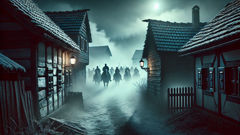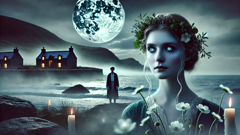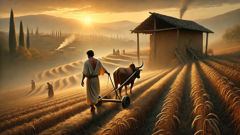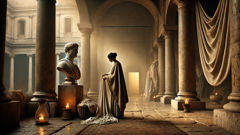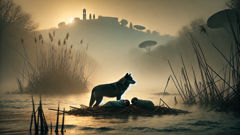Introduction
On the threshold between winter and the austerity of Lent, when the air seems to hold its breath and the last snows grind thin against the earth, villagers in some Serbian hamlets would close their shutters and speak in hushed tones of the Todorci. The name moved like a cold wind across kitchen tables and around the stove benches: Todorci — a procession of horsemen who ride with hooves striking frozen soil, whose shadows carve crescents into the yards of those who neglect the prescribed seclusion of those days. No single telling binds every detail; like all old myths, the Todorci adapt to the mouth that breathes them. In some accounts they are restless dead, condemned knights who broke sacred oaths; in others they are a demonic patrol, a consequence of rites neglected and promises broken. They come in the first week of Lent — not because they are pious, but because that week stretches the seam between the living and the hidden. The lore taught children to stay indoors, but it also shaped how communities mourned, how they repaired offenses, and how they ritually prepared to pass the fragile gateway that Lent represents. This retelling gathers the fragments of oral memory, regional ritual, and archival echoes to reconstruct an atmospheric portrait of the Todorci and the ways people met them — with fear, with rites, with stubborn small resistances that were often the only shield against being trampled into the thawing ground.
Origins and Variations: Who Are the Todorci?
Across the rolling hills, river valleys, and dense forests of Serbia, the Todorci are not a single figure so much as a communal shape: a pattern repeated and adjusted to local memory. Their origins are layered like sediment, sediment of conquest, of Christian calendar overlaying older seasonal rites, of families who told their dead to remain at bay and then watched them return in different forms. In some villages the Todorci were described simply as riders without faces, in others as men in torn wedding garments, in yet others as armored knights with rusted, bloodstreaked lances. What remains consistent across versions is timing and effect: they come during the first week of Lent and they trample anyone caught outdoors. That lethal specificity seems less arbitrary when you observe how Lent was understood in old agrarian life. The first week of Lent marks the first stubborn move away from the winter of rest; it is a time of restraint, of unbending behavior, of both communal and private reckonings. Where the Todorci step, they erase the boundary between wrongs done and justice demanded, between oaths broken and their terrible settlement.
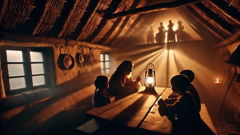
The layering of identity in the Todorci tale suggests syncretism. Some scholars of folklore trace echoes of pre-Christian processions — winter specters and horse-shaped spirits that patrol between seasons — folded together with medieval beliefs about restless spirits and punitive miracles. During medieval times the calendar, church penitential practices, and local custom all influenced one another. Lent, with its rituals of mortification and confession, offered an interpretive framework: why would a procession that punishes appear during a season devoted to examining conscience? In the lay mind, the answers varied. A neighbor might whisper that the Todorci were sinners who failed to fast, now cursed to ride for eternity; a priest might frame them as a test of the faithful; an elder woman might insist they were the unpaid debts of families who had failed to honor the dead.
The anthropological take does not fully account for the emotional power of the accounts, which persist because they supplied immediate, practical guidance. Keep your children indoors, tie the animals, keep sacred rhythms, and if a rider knocks at your door confess whatever secret wrong binds you. The stories offered both explanation and remedy. In my interviews with descendants of villages that still remember these tales, the most detailed recollections are rituals — how to seal a door, what phrases to murmur, the distribution of small tokens to the threshold to confuse the demon riders. Many of these practices seem to draw on older apotropaic customs: iron objects placed near doors, strings of garlic, bells at thresholds, and the recitation of names. These tokens served to create a boundary both physical and symbolic: the Todorci can be spoken of, bargained with, even placated, but they respect the sign that separates the ordered household from the passing world.
If we explore a few of the stronger narrative strains, we find recurring motifs. The first describes the Todorci as the dead of the village — men and women who died with grudges, their rest unmade by broken covenants. They ride to settle scores, trampling those who sinned by betraying kin. In another strain, the Todorci are demons summoned by a curse or a witch, a march of infernal cavalry that tests whether communities will hold fast to the moral order. A third variation prescribes a ritual response: a family that has dishonored the rites may avert disaster by performing a quiet act of restitution before the procession arrives. This third strain is the most instructive, revealing the myth's role as regulatory lore. The Todorci are a story and a social mechanism — a myth that enforces shared norms through dread and remedy.
But dread alone does not make a myth live. What gives the Todorci their pulse are the images and noises those who remember insist upon. People speak of hooves that do not soften on the earth, of the metallic clink of harnesses that somehow never dull with distance, of a smell that precedes them like burned hay. Some tell of a wind that empties the smoke from chimneys and leaves lamps guttering; others speak of a silence, thick and anticipatory, broken only by the distant cry of a dog. Always, there is the trampling: not simply physical crushing, but the sense of being caught in the crossing of two orders — the household and the procession, the sacred week and the profane day. When the Todorci pass, fields seem to lose a foot of height where their hooves struck, and families will not till those places for a year, believing the soil to be marked.
Such details feed modern imaginations and also, crucially, served local needs. A community that noticed a rash of accidents or moral transgressions could anchor them to a narrative that demanded action. The myth was mutable: when social priorities shifted, the details of the Todorci shifted with them. In the nineteenth century, with more centralized church instruction and migrations to towns, the story tightened into a moral fable: the Todorci punished irreligion and impiety. In more remote settings, the older, ambiguous versions persisted — guardians or predators, depending on how the household comported itself.
Those who told these stories rarely left them purely as horror tales. They contained instruction: where to hide supplications, how to read the weather for omens of the procession, and how to perform small acts of discipline to protect the vulnerable. In this way the Todorci functioned as both threat and teacher, embodying the consequences of social rupture while offering a pathway back into communal safety.
Rituals, Survival, and the Living Memory of Lent
If myths are instruments for living, then the rituals surrounding the Todorci are the chisel and file. People learned to weave tangible responses out of intangible fears. The sequences of practices — sealing doors, hanging iron and garlic, placing bells at thresholds, reciting names — do not read like random superstitions when we consider them as a system. Each element serves a function: iron as a boundary against the supernatural, garlic as continuity with agricultural cycles and protection from rot, bells as sound markers that prevent stealth, and spoken names as a way to ground identity in a world of passing forms. The combination is pragmatic: sound, sight, scent, and speech together form a safeguard. The household becomes a small, fortified island, dense with symbolic meaning.
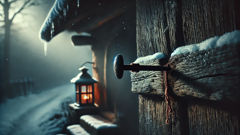
One of the most evocative practices recorded in oral histories is the ritual known as zatvaranje vrata — literally 'closing the doors'. On the eve of the first Monday of Lent, families would perform a sequence of gestures: they would wash thresholds with water salted and blessed by a priest when available; they would drive an iron nail into the lintel and tie thin red threads to it; they would place a slice of bread in a corner for the wandering souls. The actions are domestic and ordinary, but they signal an intention to hold the boundary. If a family had goods owed to neighbors or wrongs undone, they might go do the necessary reconciliation aloud at the door, to demonstrate in public that they were mending the weave. This process served social cohesion as well as spiritual protection: the Todorci myth thereby became a channel for restoring relationships.
Another common custom involved animals. Farmers would lead livestock into barns earlier than usual, placing iron loops on halters, feeding them salted hay, and scattering coins in corners of the stall to distract any curious spirits. These acts show how the myth was integrated into economic life; animals were valuable assets, and the Todorci provided a compelling reason to protect them. Where a family could not afford the brass or iron often recommended, they would improvise with polished stones or strings of beans. The principle remained: create markers of human intentionality in the face of the unpredictable.
Women in some villages kept the most detailed knowledge of calming rites. Midwives and elder neighbors had collections of phrases, a set of names and diminutives that could both call a spirit by its proper name and thereby domesticate it, or confuse it with a tangle of illegible titles. Linguistic practices matter in a myth like this: to name is to claim, to call is to bind or to misdirect. Some stories require the utterance of the name Todor to set the riders on a different path; others suggest that not naming them at all denies them the sense of being attended to and so lets them pass. The balance between speech and silence becomes central to survival strategies.
Of course, for many families the ritual was less about defeating the supernatural than about promising to be better neighbors. People often describe the calming of Todorci as contingent on performing reparative actions: distributing corn to the poor, forgiving a debt, visiting a neglected grave. The myth becomes a moral lever. In exchange for ritualized restitution, communities believed they could negotiate with the Todorci or at least blunt their fury. This element — moral bargaining — makes the myth resilient. It converts fear into a set of ethical tasks, and so it endures as a cultural practice.
Modernity has altered these practices. In towns and cities, the Todorci are more likely to be remembered as story rather than a calendar event with an associated praxis. Yet in remote hamlets and in the memory of older villagers the rituals persist in outline, and sometimes in execution. Younger generations recount an abridged ritual: a phone call to an elder to hear the words for hanging a red thread, a hastily tied nail over a new apartment door in the city. The myth migrates with people. In diaspora communities, it serves as a cultural anchor: a way to mark seasonal change and to claim continuity with an inherited moral geography.
Ethnographers who have worked in Serbian communities stress that the Todorci story also framed interpretations of symbolic weather events. A sudden white mist, a row of rutted hoof prints in the thaw, a strange pattern of sound in the trees — such things would be read through the lens of the Todorci. Belief formed a hermeneutic: the world provided signs and the myth supplied meanings. That practice of reading the environment is both pre-modern and enduring. It is also a form of practical weather lore: people learned the rhythms of seasons by attention to small anomalies that otherwise might be dismissed.
But the narrative of the Todorci has also inspired creative responses. Poets, painters, and contemporary storytellers reclaim the myth with new sensibilities, emphasizing the sadness of the riders as much as their danger. Artists imagine the Todorci as emblematic of loss and the difficulty of reconciliation, not simply as punitive figures. This reinterpretation does not erase the older uses of the myth; instead, it adds depth. A rider might represent a failed promise, a landscape marked by grief, a community's inability to integrate a moment of disruption. Such readings make the Todorci relevant to new moral questions: to how we treat memory, to how communities mend breaches, to what we owe those who are no longer with us.
In the end, the rituals and survival strategies that cluster around the Todorci reveal a culture's methods of converting fear into action. They are less about irrational terror and more about communal appetite for repair. The Todorci demand attention; that demand forged practices of public confession, of mending fences and of fortifying thresholds. It is a mythology that insists the living must perform their obligations if they wish to pass safely through the liminal week. That insistence, whether you accept it as literal or symbolic, is the truth the Todorci have long carried.
Conclusion
The Todorci remain a potent figure in the regional imagination because they occupy a space both practical and symbolic: a tale that enforces social obligations while attesting to the ways people have coped with the unknown. Their persistence testifies to the human need to turn uncertainty into ritual, sorrow into narrative, and fear into tasks that knit communities together. Whether seen as punitive ghosts, seasonal spirits, or metaphors for responsibility, the Todorci demand that the living attend to their duties during the fragile corridor of Lent. Communities responded with rites as modest as a nailed iron, as tender as a repaired promise, and as dramatic as a shared confession at a doorway. Those acts were not mere superstitions; they were social technologies — accessible, repeatable, and public — that mediated risk and preserved bonds. Today, as the world grows faster and fewer people live by the rhythms of small rural calendars, the Todorci live in story and art, in the memory of elders and in the quiet performance of ancestral rites. To listen to the tale of the Todorci is to hear not just of trampling, but of the ways a culture insulates itself against loss, summons courage in the face of ambiguity, and teaches successive generations that the threshold is a place both of danger and of salvation.

